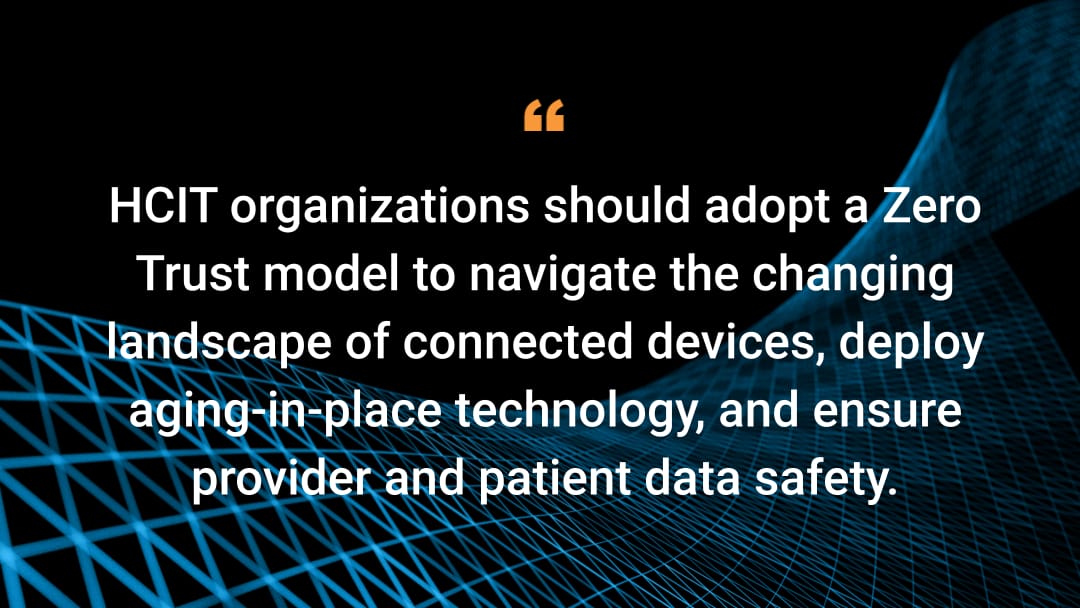Aging-in-Place: Why HCIT Professionals Should Adopt Zero Trust Security

Almost 1 of every 6 people in the United States was 65 years or older in 2020, and that proportion is only rising given the number of baby boomers who are hitting retirement age.
This comes with some serious opportunities — and challenges — in the healthcare information technology (HCIT) space. HCIT companies produce technology to promote the digitization of healthcare. Although many people may assume that tools like virtual care platforms or smart watches that monitor vital signs are adopted primarily by millennials and younger generations, the COVID-19 pandemic was a catalyst for senior citizens to adopt and embrace innovation.
During the pandemic, the novel coronavirus spread rapidly in assisted-living facilities and nursing homes. A 2023 study from the U.S. Department of Health and Human Services found that more than 1,300 nursing homes had infection rates of 75% or more in 2020 and suggested that “better protections are needed for future emergencies.”
Seniors opt to age in place
As a result, more of the country’s aging population has been motivated to live at home for as long as possible. For many HCIT innovators, it’s more important than ever to develop aging-in-place technology that enables older individuals to remain at home while still being able to receive quality care.
Many Medicare Advantage and multiple private payers’ plans now support remote patient monitoring via devices and virtual care. As a result, strategies for meeting the needs of the aging population and healthcare coverage must continue to evolve.
Pivotal changes in the healthcare landscape
Numerous smart home technologies supporting aging in place ensure patients are able to receive more continuous, less episodic care. These health technologies for seniors can be as simple as devices with Siri voice control and devices that facilitate emergency calls for falls, for example. Others — like virtual care, chronic care management, and concierge medicine — expand the healthcare ecosystem.
Virtual care
Virtual care for seniors can enhance access for those with mobility issues while decreasing appointment wait times and exposure to illnesses. Virtual care — whether on or off camera — can be provided through healthcare organizations’ proprietary technology (like electronic health records [EHRs]), third-party apps, or independent platforms not affiliated with primary care practices.
Chronic care management
Aging-in-place technology (including remote patient monitoring technologies like vital sign monitoring) can help patients who suffer from conditions like diabetes or heart disease. This technology, which can be virtual or in person, is designed to enhance preventive care by providing support between regular provider visits.
Remote patient monitoring (RPM) capabilities give providers real-time access to patient data and notifications when the data indicates a patient at risk. This can improve care outcomes for chronically ill patients. RPM can also help physicians monitor prescription efficacy and adherence for patients taking critical maintenance medications.
Concierge medicine
House calls are back in the form of concierge medicine, a healthcare subscription model that’s often supplementary to other health plans. Patients subscribe and pay a fee to see a provider who visits them at home instead of in an office.
Interoperability and EHRs are critical to this model, as they ensure that providers have historical and real-time information about the patients they see. Concierge providers often use their own devices (like tablets) in patients’ homes and need to be connected to patient records and hospital systems remotely.
HCIT challenges and concerns
Although the COVID-19 public health emergency has been recently lifted, many seniors still opt for aging-in-place technology, according to a 2023 survey by U.S. News & World Report. Unfortunately, with the increased use of technology comes some challenges and concerns for HCIT companies, providers, and patients.
One of the biggest challenges HCIT professionals must address is the heightened need for security. All communication between patients and providers must be secure, especially considering the evolution and challenges of cyberthreats.
In 2022 alone, 66% of healthcare organizations suffered a ransomware attack, and it took one week on average to recover from those attacks. The average cost of a U.S. ransomware attack was $1.85 million. These findings give clear insight into the critical importance of cybersecurity in the healthcare industry.
Another roadblock that HCIT organizations face is uptime. Real-time access to medical records and devices that monitor vital signs are critical to providing the best care. If there is a system outage — even for a few seconds — it can have detrimental impacts on patient outcomes.
Fortify against cyberattacks with microsegmentation
HCIT organizations should adopt a Zero Trust model to navigate the changing landscape of connected devices, deploy aging-in-place technology, and ensure provider and patient data safety. This security framework requires all users, whether inside or outside the organization’s network, to be authenticated, authorized, and continuously validated for security configuration and posture before being granted access to data and applications.
A Zero Trust model limits the “blast radius” and minimizes impact if a breach occurs. One important component of Zero Trust is microsegmentation, which divides networks into smaller, isolated components so healthcare organizations can prevent the lateral spread of cyberattacks.
Key capabilities include but aren’t limited to:
Authentication and authorization, including multi-factor authentication (MFA)
Visibility of on-premises, cloud environments and Internet of Things devices
Granular access policies (application access vs. access to the entire network)
Security at the edge
Improved application performance
Automation and integration capabilities
MFA for secure gateway has risen quickly to meet the cybersecurity challenges accompanying aging-in-place technology and other digital healthcare tools. Microsoft reports that multi-factor authentication could prevent almost 100% of account compromise cyberattacks.
What’s next?
By adopting a Zero Trust approach, HCIT professionals can improve their risk management practices, enhance patient data security, and foster a more connected and efficient healthcare system to meet the increasing shift to aging in place.
Contact us today to learn more about how Akamai can help.


